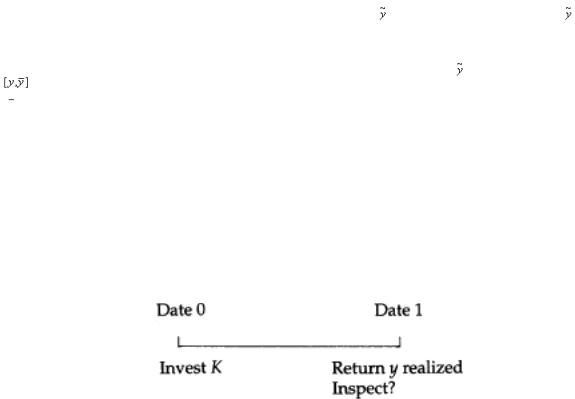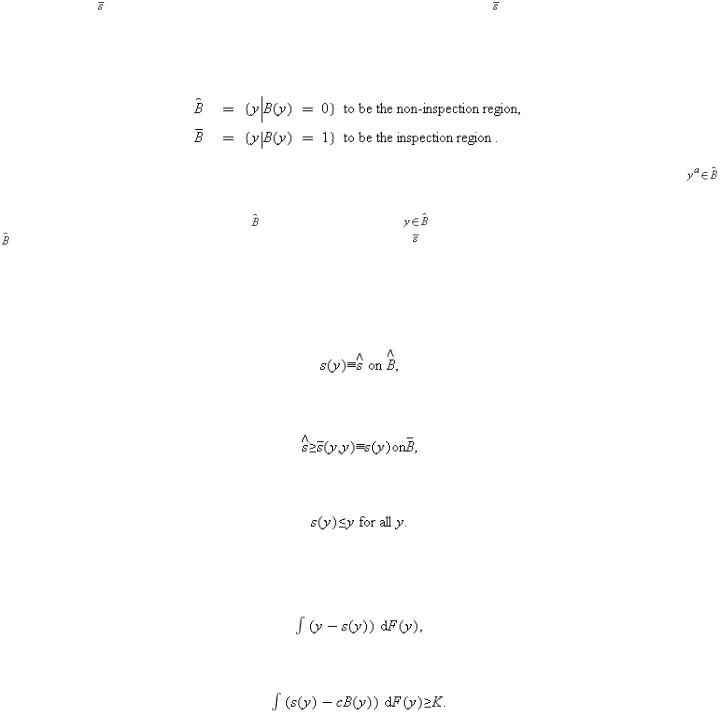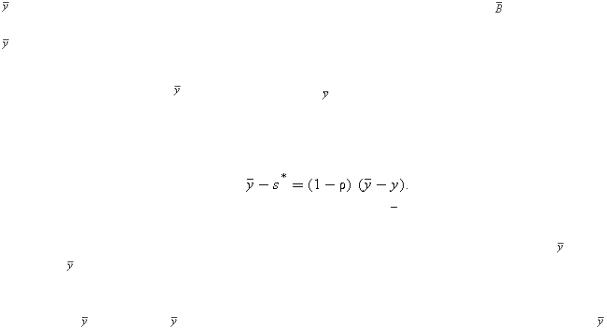
Учебный год 22-23 / Firms, Contracts, and Financial Structure
.pdf
120 |
II. UNDERSTANDING FINANCIAL STRUCTURE |
|
example, in the Hart–Moore (1989) model, if |
, the investor, who in effect owns the assets, negotiates for an |
|
explicit payment at date 1 in return for not liquidating the project.) Or the firm's profit is, at least partly, verifiable (as in the Aghion–Bolton model)—in which case an investor's return can be in the form of a contractually specified payment. In practice, equity-holders often get substantial returns in the form of dividends that are neither explicitly negotiated for, nor contractually specified. (A dividend is a discretionary payment made by management.) It would be very desirable to extend the analysis of this chapter to explain dividend payments of this sort, and thereby provide a more interesting role for equity finance. (Chapter 6 provides a further discussion of equity finance.)
Second, the models of this chapter have been partial equilibrium in nature. Among other things, they have taken the liquidation value of the project assets to be exogenous. In reality, however, liquidation values—the resale value of the project assets—will depend on the financial position of other entrepreneurs and investors, since such parties are the potential purchasers of these assets. The resulting interaction and feedback effects have been studied in two very interesting recent papers by Shleifer and Vishny (1992) and Kiyotaki and Moore (1995). Shleifer and Vishny show that, because of these interactions, firms in cyclical industries will rely less on debt finance, because, when they are financially distressed, potential purchasers—other firms in the same industry—will also be financially distressed and so liquidation values will be low. Kiyotaki and Moore show that feedback effects may cause fluctuations in demand to be amplified: a reduction in the demand for and price of capital goods may lead to further reductions in demand as firms whose collateral has diminished in value find it difficult to borrow for further investment.
The Shleifer–Vishny and Kiyotaki–Moore papers are significant first steps in the general equilibrium analysis of financial contracting. Much remains to be done on this topic.

5. FINANCIAL CONTRACTING AND DEBT |
121 |
Appendix
The Costly State Veri cation Approach
In this appendix, a simple version of the CSV approach is described. Consider a risk-neutral entrepreneur, E, who has no initial wealth and wants to invest in a project costing K. The entrepreneur approaches a rich risk-neutral investor, C, to provide the funds. If the investment is undertaken, it yields a return at date 1. The realization of is learned by E at date 1, but not by C. That is, there is asymmetric information at date 1. However, this asymmetry of information can be removed if C ‘inspects’ E at cost c. For simplicity, take the interest rate to be zero. Also suppose that there is
symmetric |
information at date 0 and that the probability distribution F of |
has a density function f with |
support, |
. The question is: will the investment be undertaken? (See Figure 5A.1 for a time-line.) |
|
The well-known revelation principle tells us that attention can be restricted to contracts (or mechanisms) in which E makes a truthful announcement about y at date 1 (see Fudenberg and Tirole 1991: ch. 7). Depending on what E announces, the contract then specifies whether inspection or non-inspection should occur and how much E must hand over to C.
CONTRACT (A1) A (deterministic) contract specifies an inspection function B: +→{0, 1} and sharing rules s: +→ , : +× +→ . The interpretation is as follows. E announces ya at date 1. If B(ya)=0, no inspection takes place and E hands over s(ya) to C, keeping the remainder y−s(ya) for himself. If B(ya)=1, C inspects E (at a cost of c, paid by C)
: +× +→ . The interpretation is as follows. E announces ya at date 1. If B(ya)=0, no inspection takes place and E hands over s(ya) to C, keeping the remainder y−s(ya) for himself. If B(ya)=1, C inspects E (at a cost of c, paid by C)
Fig. 5A.1

122 |
II. UNDERSTANDING FINANCIAL STRUCTURE |
and C receives |
(ya, y), where y is the inspected value. In this case, E keeps y− (ya, y) for himself. |
Simplify contract (A1) as follows. Since the goal is to encourage truth-telling, it is always optimal to set  (ya, y)=y if ya≠y. That is, E should receive nothing if an inspection reveals that he has lied. It follows that E will lie only if his false announcement ya satisfies B(ya)=0. Define(5A.1)
(ya, y)=y if ya≠y. That is, E should receive nothing if an inspection reveals that he has lied. It follows that E will lie only if his false announcement ya satisfies B(ya)=0. Define(5A.1)
The relevant truth-telling (or incentive compatibility) constraints are then that (i) E should not announce different from the true  ; (ii) E should not announce
; (ii) E should not announce  different from the true y
different from the true y  .
.
(i) implies that s(y) is a constant, ŝ say, on . Otherwise, whenever (since E receives y−s(ya) and is not inspected). (ii) implies that ŝ≥
 rather than y
rather than y  .
.
E would announce the ya that minimizes s(y) on (y, y) for y  , since otherwise E would announce
, since otherwise E would announce
Finally, s(y)≤y for all  and
and  (y, y)≤y for all y
(y, y)≤y for all y  , since otherwise it is not feasible for E to tell the truth. The above observations can be summarized as follows, where
, since otherwise it is not feasible for E to tell the truth. The above observations can be summarized as follows, where  (y, y)≡s(y):(5A.2a)
(y, y)≡s(y):(5A.2a)
(5A.2b)
(5A.2c)
An optimal contract is a mechanism (s(y), B(y)) satisfying (5A.2a)–(c) that maximizes E's return,(5A.3)
subject to C's breaking even:(5A.4)
Note that the inspection cost—incurred if and only if B(y)=1—has been included in C's return.
The next proposition states that the optimal contract has a very simple form. It is characterized by an amount that E owes C, s*. If y≥s*, E pays this amount and is not inspected. If y<s*, E is

5. FINANCIAL CONTRACTING AND DEBT |
123 |
inspected and C receives the whole of y. If ‘inspection’ is interpreted as ‘bankruptcy’, then the optimal contract has the character of a standard debt contract with repayment s*. The proposition is proved in Gale and Hellwig (1985).
PROPOSITION A1. Assume that the project goes ahead, i.e. that there is a mechanism satisfying (5A.2) and (5A.4). Then the optimal contract has the following form (ignoring sets of measure zero): For some  for
for  , s(y)=y for y
, s(y)=y for y  .
.
Proposition A1 is the main result of the CSV theory and explains the use of debt financing. However, both the proposition and the CSV approach itself are subject to various qualifications.
1.Proposition A1 is derived under the assumption that only deterministic contracts are feasible. It is easy to see, however, that a stochastic scheme may improve matters. Consider the simple case where y takes on two values, with probability σ and y with probability (1−σ), and suppose y<K and σ +(1−σ)y>K. (The argument generalizes to the case of continuous y.) An optimal deterministic contract will specify a payment s* where
>s*>y. As a result, inspection takes place with probability 1 when y=y. Now consider the following stochastic contract:
CONTRACT (A2). E announces or y. If he announces , he pays s* to C. If he announces y, then with probability (1−ρ) he is not inspected and pays y to C; and with probability ρ he is inspected and pays everything to C. Here ρ is chosen so that
(5A.5)
(5A.5) ensures that the stochastic contract satisfies the truth-telling constraints. In state , E is prepared to announce since he is indifferent between telling the truth and announcing that the state is y. On the other hand, in state y E must tell the truth since he cannot afford the payment s*.
This stochastic contract is Pareto-superior to the deterministic debt contract. E receives the same payoffs in both states (( −s*) in state , zero in state y), while C receives the same gross payoffs (s* in state ,y in state y), but with probability (1−ρ) avoids inspection costs in state y. Obviously, s* could be adjusted so that both E and C are better off than in the deterministic contract.
The main problem with stochastic contracts is that they cannot

124 |
II. UNDERSTANDING FINANCIAL STRUCTURE |
easily be interpreted as debt. (For a general analysis of stochastic contracts, see Mookherjee and Png (1989).) The contract in (5A.5) seems closer to a (stochastic) auditing scheme than to a debt contract. I return to this theme in point 5 below.
2.The CSV model described above supposes that C can commit to a particular inspection rule and that there is no possibility of ex post renegotiation. To see why this is important, consider the following example. Suppose the
entrepreneur's return =100 with probability 1 and the verification cost c=20. According to the CSV model, a debt contract in which the entrepreneur promises to pay 90 can be enforced. The reason is that, ex post, the entrepreneur prefers to pay 90 and be left with 10 than default and get nothing. However, this assumes that the investor's threat to incur the verification cost and confiscate the entrepreneur's funds is credible. Suppose the entrepreneur hands over just above 80 instead of the promised 90. Then the investor (unless she has a reputation to uphold) will choose not to inspect the firm since the gain is less than the verification cost of 20. Thus, in the absence of a commitment not to revise or renegotiate the verification decision, the most that the investor can force the entrepreneur to pay is 80.
In the above example, the analysis of renegotiation is relatively straightforward. However, matters become a great deal more complicated when the entrepreneur's payoff is uncertain. The reason is that the amount handed over by the entrepreneur is a signal of his total return. As in many signalling models, there can be multiple ex post equilibria, with the signal being interpreted in various ways. While refinements can eliminate some of these equilibria, the analysis of optimal ex ante contracts quickly becomes complicated (see Gale and Hellwig 1989).
3.In reality, debt typically coexists with equity as a financial claim on a firm. Yet the CSV model does not seem able to explain the existence of dividends and (outside) equity. The point is that in non-bankruptcy states E always makes a payment that is just enough to satisfy creditors; there is never anything left over for other claimants (except of course E himself—in this respect E is the 100 per cent equity holder). And, of course, in bankruptcy states outside shareholders receive nothing because there is not enough even to satisfy creditors. (As noted, the incomplete contracting models of debt described in the text also have a hard time
5. FINANCIAL CONTRACTING AND DEBT |
125 |
explaining dividends. However, they are consistent with a positive value of equity since equity-holders can use their power to liquidate the firm to extract a payment from the entrepreneur.)
4.The cost c of verifying the state of the world plays a crucial role in the CSV model. But what is c? Is it an auditing cost, the legal cost of bankruptcy proceedings, or what? The reason this matters is that for the model's results to be interesting c must be reasonably large. Otherwise one could approximate the first-best by inspecting E all the time. However, auditing costs do not seem that large and empirical work has not identified large (direct) bankruptcy costs (see e.g. Warner 1977).
5.Perhaps most important of all, the model is based on a comprehensive contracting/mechanism design view of the world. According to such a view, the contracting parties sit down at date 0 and write a renegotiation-proof contract that specifies each party's obligations in every future contingency. This appendix has shown that under a simple set of assumptions the optimal contract can be interpreted as a debt contract. However, this is unlikely to be a very general result. With more periods, one would expect the contract to specify that inspection should take place at several dates—as a (possibly stochastic) function of past events. Moreover, in a multi-period setting there is no reason to think that inspection should be associated with a termination of the firm's operations, in the way that bankruptcy often is. Rather, inspection is simply a normal event in a firm's life.
In other words, the CSV model—when extended—seems to be closer to a theory of optimal inspection or auditing than to a theory of debt or bankruptcy.
6 Capital Structure Decisions of a Public Company
IN the last chapter, I discussed the optimal contract written by an entrepreneur who raises capital from an investor (or set of investors). I assumed that the entrepreneur obtained significant (private) benefits from running a firm, and analysed how control rights could be allocated between the entrepreneur and investor, so as to give the entrepreneur maximum freedom to pursue his own goals, subject to the investor breaking even.
In this chapter I extend the analysis to the case of a large, public company. Although there is no sharp economic distinction between the private and public cases, I take the point of view that in the case of a public company the issue of allocating control rights to managers in order to give them a chance to enjoy private benefits may not be of primary importance. Also, it may not be necessary to give managers control rights in order to motivate them to undertake relationship-specific investments, or to be innovative or inventive, given that many of the actions of the managers of a large company are relatively routine.137 Rather, the crucial issue may be how the company's investors can design financial structure so as to limit management's ability to pursue its own goals at the expense of investors. For example, managers may overpay themselves and give themselves extravagant perks; they may carry out unprofitable but powerenhancing investments; or they may refuse to give up their jobs to others who can run the company better. (In contrast, it is supposed that investors are interested only in profit or net market value.)138
In the case of a single investor, it is clear how to deal with this problem: give the investor all the control rights; i.e., make her the 100 per cent owner. (See the Aghion–Bolton model in the case
137This is in contrast to the case of an entrepreneur, where innovation and inventiveness may be extremely important.
138On managerial goals, see e.g. Baumol (1959), Marris (1964), Jensen (1986), and Williamson (1964).
6. CAPITAL STRUCTURE OF A PUBLIC COMPANY |
127 |
where the entrepreneur's utility does not matter, or where the investor has all the bargaining power.) However, this chapter supposes that investors are wealth-constrained and so the company has many small investors.139 This creates two new issues that were not relevant in the case of the private company considered in Chapter 5. First, those who own the company, the shareholders, are too small and numerous to exercise control on a day-to-day basis. Given this, they delegate day-to-day (residual rights of) control to a board of directors who in turn delegate it to management. In other words, to use the phrase made famous by Berle and Means (1932), there is a separation of ownership and control.140
Second, dispersed shareholders have little or no incentive to monitor management. The reason is that monitoring is a public good: if one shareholder's monitoring leads to improved company performance, all shareholders benefit. Given that monitoring is costly, each shareholder will free-ride in the hope that other shareholders will do the monitoring. Unfortunately, all shareholders think the same way and the net result is that no—or almost no—monitoring will take place.
Sometimes this free-rider problem can be overcome by someone who acquires a large stake in the company and takes it over (or exerts control in some other way). However, the take-over mechanism does not always work well.141 The conclusion is that in many cases the managers or board of directors of a public
139 Investors may also be small because they are risk-averse and want to hold diversified portfolios.
140 A more accurate description might be that there is a separation of ownership and effective control or management. The point is that the shareholders do retain ultimate control in the form of votes.
141One reason is that a bidder may have to share a large fraction of the take-over gains with shareholders of the target company, because (i) minority shareholders can earn a capital gain by holding on to their shares (see Grossman and Hart 1980); or (ii) the bid may alert others to the fact that the company is undervalued and a bidding war may
ensue. Thus, the bidder may fail to cover the ex ante costs of making a bid. Further factors deterring a bidder are management's ability to engage in various defensive measures (lawsuits, poison pills, the introduction of employee stock ownership plans); to invite ‘white knights’ to make bids and favour these bidders by giving them nonpublic information; or, at the last moment, to carry out the actions the bidder was planning to undertake. The evidence does indeed show that most of the gains from a successful take-over accrue to shareholders of the target firm rather than to the acquiring firm; see Bradley et al. (1988) and Jarrell et al. (1988). For a further discussion of takeovers, see Chapter 8.
128 |
II. UNDERSTANDING FINANCIAL STRUCTURE |
company can pursue their own goals, possibly at the expense of those of shareholders, with little or no outside interference.142
This chapter studies how the owners of a company can constrain the behaviour of management when there is a separation between ownership and control. One possibility is to put managers on an incentive scheme. However, while an incentive scheme may work well in motivating managers to exert effort, it is likely to be less effective in getting managers to cut back on empire-building or to relinquish control. The reason is that, if managers have a strong interest in power, empire, and perks, a very large bribe may be required to persuade managers to give up these things. It may be better for investors to force managers to curb their empire-building tendencies. Placing debt in the capital structure is one way to do this. Moreover, debt is more flexible than an incentive scheme in that it makes the set of choices available to the manager sensitive to the market's assessment of company prospects.
This chapter illustrates the constraining role of debt using two simple models. In both there is a conflict of interest over the assets that should be under management control. In the first model the focus is on whether management should shrink its empire over time. The second model considers the closely related question of how much management should expand its empire. The reason for considering two models is that the situations of asset liquidation and expansion are analytically distinct. In the first short-term debt is critically important, while in the second long-term debt plays a more significant role. However, there is a short discussion in the text, and a longer discussion in the Appendix, of a special case in which the two models can be merged.
The chapter is organized as follows. Section 1 introduces some of the assumptions behind the models, while the models are developed in Sections 2–4. Section 5 argues that, even though the
142In this book no distinction is made between management and the board of directors; that is, the role of the board in ensuring that managers act on behalf of shareholders is ignored. This is a reasonable assumption in many cases. Board members are often picked by incumbent managers, and are likely to feel loyal to them. Also, board members are typically not major shareholders in the company, and therefore have little incentive to play an active role. On the other hand, there are undoubtedly occasions—some of
which generate a great deal of publicity—when the board does intervene and constrain management. On these issues, see Mace (1971), Vancil (1987), and Weisbach (1988).
6. CAPITAL STRUCTURE OF A PUBLIC COMPANY |
129 |
models are very simple and stylized, they can explain some of the empirical evidence about capital structure. Section 6 compares the ‘incentive’ or ‘agency’ approach described here with other theories of capital structure in the literature.143 Much of the literature has either ignored agency problems altogether, stressing the tax or market completion benefits of debt, or has focused on the conflict of interest between shareholders and creditors, rather on that between investors and management.144 I shall argue that only by considering the conflict between investors and management can one explain why companies issue senior debt, and why a failure to make a debt payment leads to a penalty in the form of bankruptcy, i.e. why debt is associated with a hard budget constraint.
1.Introduction to the Models
The models used in this chapter differ from those in Chapter 5 in several respects. It is worth spelling out some of the key assumptions made before the formal analysis begins.
1.It is now supposed that the company has a large number of small investors; that is, its equity and debt are dispersed.
2.It is assumed that capital structure decisions are made to maximize the expected return to investors, rather than to maximize management's utility subject to investors breaking even. It is also supposed that management's utility is at least as high as what it can get elsewhere, i.e. that management's participation constraint is not binding.
3.The analysis considers the (admittedly) extreme case where the manager's utility is strictly increasing in the assets under his control, and is completely independent of his monetary compensation (his salary).
4.It is supposed that management cannot divert all of the firm's profit for its own use. As a result, (outside) equity will have a positive market value in equilibrium.
143For a survey of the literature on capital structure, see Harris and Raviv (1991).
144On the conflict between shareholders and creditors, see Jensen and Meckling (1976). Papers that do deal with the conflict between investors and management include
Grossman and Hart (1982), Jensen (1986), and Stulz (1990). The analysis in this chapter is based closely on Hart (1993) and Hart and Moore (1995).
